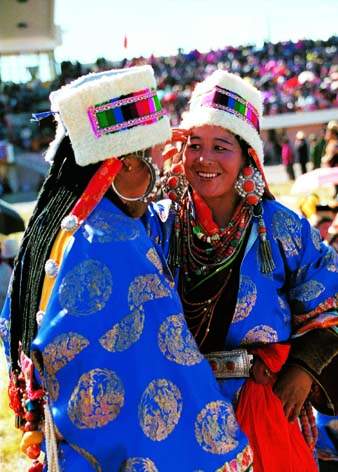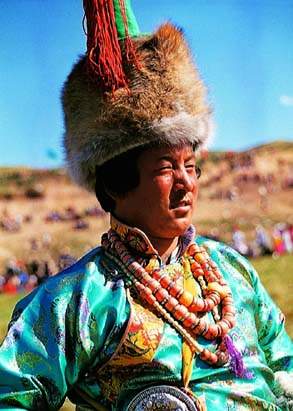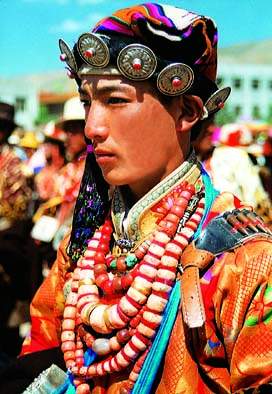
Tibetan garment adornments are largely identical, although with some minor differences, and the adornments of Amdo are a major branch.
Hats
Like other Tibetan-inhabited areas, there are various kinds of hats in Amdo. According to the season, they can be classified into winter and summer hats; in the light of different characteristics, they are sorted into common hats, hats for artists, for monks and for herdsmen; when it comes to styles, they fall into four major categories, namely, four-flap hat, hat made of fox fur, bowler hat, and lambskin hat.
Four-flap Hat. There are four symmetrical U-shaped flaps at the lower part of the hat, which are mainly made of black woolen cloth. Men and women from cities, counties, and agricultural areas usually wear this kind of hat. The men's hat is columnar, round and tall, and women's hat is elliptical and relatively lower. Most of the four-flap hats are made of valuable fur of the otter or other animals. Golden satin enlaces the hat in the shape of regular circular leafy lines or ripples. Currently, the hat is popular throughout the whole Tibetan-inhabited areas.
Fox Fur Hat. In agricultural areas, people divide a fox skin in half and make two hats. The hat is about 30cm high, black-colored, with wrinkles on its top.
Fox fur is sewed up at the lower part of the bell-shaped hat and the fur is folded up. In pasture areas, the hat is made by a complete piece of fox skin. It is tall, round-topped with no pleats at all, and its top just droops down behind the head. In some other areas, a complete piece of fox skin is simply processed and wrapped around the head, and the head, tail and limbs of the fox are tied behind, with the tail drooping behind the ear.
Bowler Hat. This is mostly worn by herdsmen, with a snap fastener on each side of the hat and on the brim.
Lambskin Hat. This is popular in pasturing areas and is made of superb lambskin of solid color. It is cheap, low and has various shapes. Lambskin is sewed up at the lower part with the same height of the hat body. The lambskin part is always folded up or unwrapped. The material used for the body of the hat can be selected casually according to people's preference.

Tibetan Robes
Tibetan people like wearing robes. Amdo robes are almost the same as those in other Tibetan areas. Generally, there are five types-robe made of pulu woolen fabrics, lambskin robe, sheepskin robe, woolen robe, and garment.
Robe Made of Pulu Woolen Fabrics. The pulu woolen fabrics in the area surrounding Lhasa are quite famous. Aristocrats and feudal lords in the olden days usually wore this kind of robe when participating in important activities. Poor farmers and herdsmen also wore it while pasturing and farming. The robe made of pulu woolen fabrics in Amdo is mainly deep red and is very warm. It is stout and durable, useful in every season and can be used as a raincoat as well.
Lambskin Robe. This sort of robe can be divided into white and black lambskin, with the latter considered valuable currently. Lambskin is ranked into several levels according to the length of the lamb hair, the degree of curliness, and the quality of the skin. The same level of lambskin is used in making robes. Generally, more than 40 pieces of lambskin are necessary to make a medium-class Tibetan lambskin robe.
Sheepskin Robe. This is popular in Tibetan-inhabited areas. There are two types -a robe made of goatskin and of sheepskin. Women in agricultural areas usually wear goatskin robes. The quality of sheepskin varies in different seasons; therefore, it is classified into winter sheepskin, summer sheepskin and autumn sheepskin.
Woolen Robe. It is made with the inner layer of sheep fur, so it is light and warm.
Garments. It is popular in the agricultural areas with low altitude and warm temperature. It has the characteristics of coolness and comfort.
Undershirt. There are two kinds of undershirt-the kind with buttons on the right and the kind with buttons down the front. Monks or those who have a predestined relationship with Buddha often wear undershirts in orange and light yellow.

Adornments
Adornments are usually used on plaits, the neck, wrist, edge of garments, and around the waist.
There are many kinds of plait adornments. Headgear made of coral and amber are viewed as the best adornments, which are mostly worn by young girls.
Plait adornments for women are usually seen in areas of northern Amdo. Large coral and agate are arranged at regular intervals down the plaits, with golden and silver handicrafts between them.
Women in pastoral areas pay much attention to plait adornments, and women in agricultural areas take the headdress as their emphasis of adornment.
The headdress prevalent in agricultural areas is rectangular, and is about 12-13cm wide. There are two types of headdress used by women in pastoral areas.
The bigger type is rectangular with six bowl-shaped silver shields at the center and 23 small bowl-shaped silver shields ranging around, and red fringes are decorated on the bottom. The smaller type is square in shape, and beset with valuable agate, coral, turquoise, etc. It has red fringes on the bottom.
There are also earrings set with coral and turquoise in the Amdo area.
Necklaces in the Amdo area feature a large piece of coral in the middle. Often, a large piece of coral or gemstone adorns the necklace of the wealthy.
The fringes of robes are frequently interspersed with otter skin and set off by colorful pulu woolen fabrics. Nowadays, the color, luster, and the width of otter skin have become symbols of wealth.
